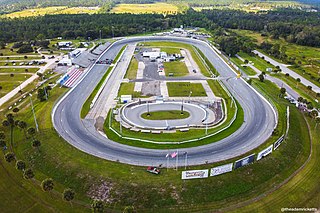
An open-wheel car is a car with the wheels outside the car's main body, and usually having only one seat. Open-wheel cars contrast with street cars, sports cars, stock cars, and touring cars, which have their wheels below the body or inside fenders. Open-wheel cars are built both for road racing and oval track racing. Open-wheel cars licensed for use on public roads, such as the Ariel Atom, are uncommon, as they are often impractical for everyday use.

Stock car racing is a form of automobile racing run on oval tracks and road courses measuring approximately 0.25 to 2.66 miles. It originally used production-model cars, hence the name "stock car", but is now run using cars specifically built for racing. It originated in the southern United States; its largest governing body is NASCAR. Its NASCAR Cup Series is the premier top-level series of professional stock car racing. Australia, Canada, New Zealand, Mexico, Brazil, Argentina, and the United Kingdom also have forms of stock car racing. Top-level races typically range between 200 and 600 miles in length.

Sprint cars are high-powered open-wheel race cars, designed primarily for the purpose of running on short oval or circular dirt or paved tracks. Historically known simply as "big cars," distinguishing them from "midget cars," sprint car racing is popular primarily in the United States and Canada, as well as in Australia, New Zealand, and South Africa.

The Trans-Am Series presented by Pirelli is a sports car racing series held in North America. Founded in 1966, it is sanctioned by the Sports Car Club of America (SCCA). Primarily based in the United States, the series competes on a variety of track types including road courses and street circuits. Trans-Am is split into the TA and TA2 classes for silhouette racing cars, while its production classes are the GT, SGT, and XGT.
Dirt track racing is a form of motorsport held on clay or dirt surfaced oval race tracks often used for thoroughbred horse racing. Dirt track racing started in the United States before World War I and became widespread during the 1920s and 1930s using both automobiles and motorcycles. Two different types of race cars dominate — open wheel racers in the Northeast and West and stock cars in the Midwest and South. While open wheel race cars are purpose-built racing vehicles, stock cars can be either purpose-built race cars or street vehicles that have been modified to varying degrees. There are hundreds of local and regional racetracks throughout the nation. The sport is also popular in Australia, New Zealand, Canada, South Africa and the United Kingdom.

The American Speed Association (ASA) is a sanctioning body of motorsports in the United States formed in 1968. The Association was based in Pendleton, Indiana, and later in Daytona Beach, Florida. The ASA sanctioned asphalt and dirt tracks in their ASA Member Track program along with racing series in the United States and Canada.
Mike Cope is a retired American stock car racing driver. A two-time champion of the NASCAR Slim Jim All Pro Series, he also competed in the NASCAR Busch Series and NASCAR Craftsman Truck Series. He is no relation to Daytona 500 winner Derrike Cope.

Seekonk Speedway is a family entertainment venue that features racing of all kinds on a semi-banked 1/3 mile asphalt-paved oval, located on U.S. Route 6 in Seekonk, Massachusetts.
Delaware Speedway is a half-mile paved race track that is one of the oldest continuously operating tracks in Canada. It is located a few minutes west of London, Ontario northeast of Delaware, Ontario. It hosts stock car racing every Friday night during the summer. The track opened in 1952 as a quarter-mile dirt track that was paved in 1960. In August 1969, the track was expanded to a 1/2 mile paved oval and continues today.

The Oswego Speedway is a 5/8 mile race track in Oswego, New York. It was built in 1951 and was paved with asphalt since the 1952. The track has held dates on several national tours - the NASCAR Whelen Modified Tour, ASA National Tour, and USAC Silver Crown Series. It was temporarily covered with dirt in 2016 when it held a one-off Super DIRTcar Series race. The track is the Labor Day Weekend home of the 200-lap, non-wing, big-block supermodified Budweiser Classic and Race of Champions.

New Smyrna Speedway is a 1/2-mile asphalt oval racetrack located near New Smyrna Beach, Florida, that races the NASCAR Advance Auto Parts Weekly Series every Saturday night. It also has a smaller track, known as "Little New Smyrna Speedway" in the infield. This track races quarter midgets on Friday nights.

The Mid-Am Racing Series, formerly Mid American Stock Car Series, is an elite sportsman traveling stock car racing series in the Midwestern United States. The cars are based on a 108" metric stock frame, less costly suspension parts and a maximum of 358 cubic inch engine. The car's roll cage and chassis were made of a design very similar to the same chassis a previous design of NASCAR cup chassis, but have also included more modern safety features such as plated door bars and the "Earnhardt bar" which runs from the roof to the dash. The series runs primarily on paved racetracks but also appears on dirt and road courses. The series is the highest form of racing available to sportsman-style, GM metric chassis stock cars.
The SRL Southwest Tour Series is a late model stock car racing league operating since 2001. The series is a continuation of the Tri-Track Challenge run in California between 1997 and 2000. The series is also connected to the former Supermodified Racing League, previously headed by Davey Hamilton. Through the years the series expanded its racing calendar as well as racing series adding spec late model series and Legends car racing.

The Illiana Motor Speedway is a closed race track located in Schererville, Indiana, United States and was built in 1947. Located about 35 miles (56 km) from downtown Chicago, Illinois, United States; the Illiana Motor Speedway is the only 1/2 mile paved oval in the Chicago area. It was announced on March 11, 2016 that the track would not open for the 2016 season. The track has been sold to the town of Schererville.

Modified stock car racing, also known as modified racing and modified, is a type of auto racing that involves purpose-built cars simultaneously racing against each other on oval tracks. First established in the United States after World War II, this type of racing was early-on characterized by its participants' modification of passenger cars in pursuit of higher speeds, hence the name.

The Ontario Stock Car Association of Asphalt Racers, usually shortened to the acronym OSCAAR, is a Canadian stock car racing series featuring three divisions, Open Wheeled Modifieds, Hot Rods and Pro Sprint. It has been running since 1990, with Dave Burbridge winning the inaugural championship. Previously the series included an Outlaw Super Late Models division.

William Prietzel is an American racing driver from Richfield, Wisconsin. He has raced in dirt late models, the Mid-American Stock Car Series, SCCA, and had one NASCAR Nationwide Series start in 2012. He is nicknamed the "Franklin Flyer" as he lived in Franklin, Wisconsin during his dirt track racing days.
Utica-Rome Speedway is a 1⁄2-mile dirt oval raceway in Vernon, New York. It is known as the “Home of Heroes” and has been the home track of several NASCAR national champions.
Brent Crews is an American professional dirt track and stock car racing driver. He competes full-time in the SCCA Trans-Am TA2 ProAm Series, driving the No. 70 Ford Mustang for Nitro Motorsports, full-time in the CARS Late Model Stock Tour, driving the No. 29 Toyota Camry for Kevin Harvick Incorporated, and part-time in the ARCA Menards Series, driving the No. 55 Toyota Camry for Venturini Motorsports. He is currently a member of Toyota Racing Development's TD2 driver development program.

Connor Zilisch is an American racing driver. He is signed as a development driver for Trackhouse Racing as of 2024. Under that agreement, Zilisch competes in select races across multiple racing series, including the NASCAR Xfinity Series, the NASCAR Craftsman Truck Series, the ARCA Menards Series, the CARS Tour, the Trans-Am Series, the IMSA SportsCar Championship and the Global MX-5 Cup.
















